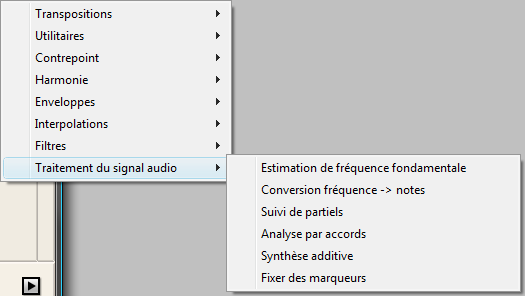Audio Signal Processing
![]()

Fundamental Frequency Estimation
- Input : a sound
The sound analysis returns an envelope corresponding to the evolution of the fundamental frequency over time. Y -points are expressed in Hz, x -points are expressed in ms.
Frequencies to Notes Conversion
- Input : an envelope
-
Choose a range between a lowest and a highest note.
-
Enter the values in ms of the starting and ending of the temporal segment to convert.
The fundamental frequencies that were detected are converted into a melodic sequence.
The envelope used for this operator must be in a valid frequency range and reasonable time interval.
It can for instance be the result of the previous (inverse) operation : fundamental frequency estimation .
Partials Tracking
- Input : a sound
- Choose a range.
- Enter the number of partials to track in the audio file in the Polyphony frame.
Partials are represented by a succession of notes in the resulting sequence .
Stereo audio files will produce two different sequences (one for each audio channel).
Chord Sequence Analysis
Input : a sound – with possible markers

- Choose a range
- Enter a number of notes to detect in the Max-polyphony frame.
The operator returns an average of the partials that were detected, for the whole segment, or at each marker. This type of analysis allows the user to represent the evolution of a spectra via chords, for instance.

Set Time Markers
- Input : a sound
- Factor : a sequence , a rhythmic sequence
Drag a sequence or a rhythmic sequence to the Sequence frame.
Each note of the sequence determines the location of a marker in the sound . If the sequence is longer than the sound file , the last notes are ignored. This operator allows to synchronize a chord sequence analysis with a sequence , for instance.
Additive Synthesis
- Input : a sequence
MIDI notes are converted into sines with a corresponding pitch, velocity and duration. The resulting sound is normalized.
